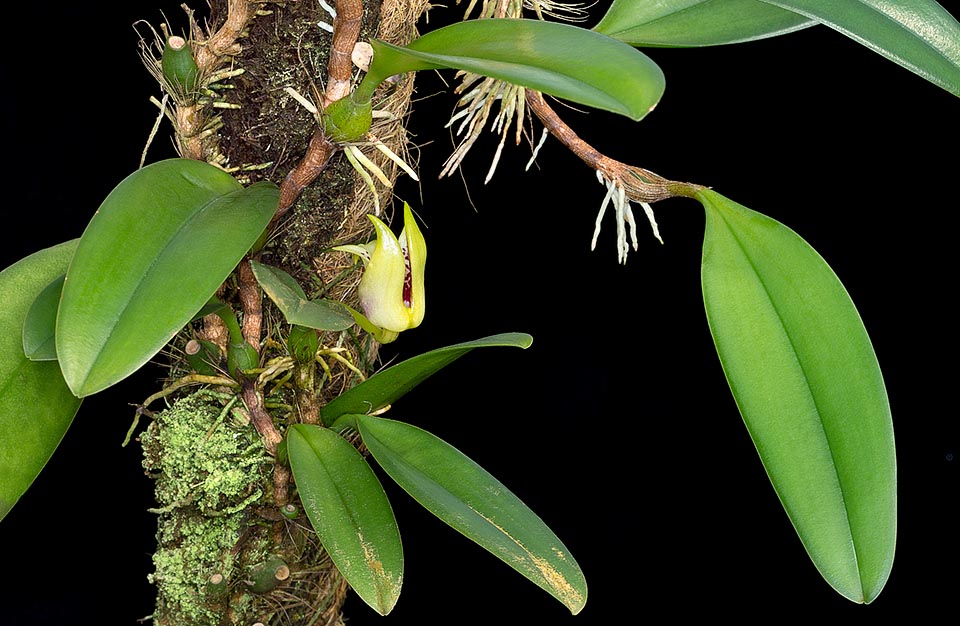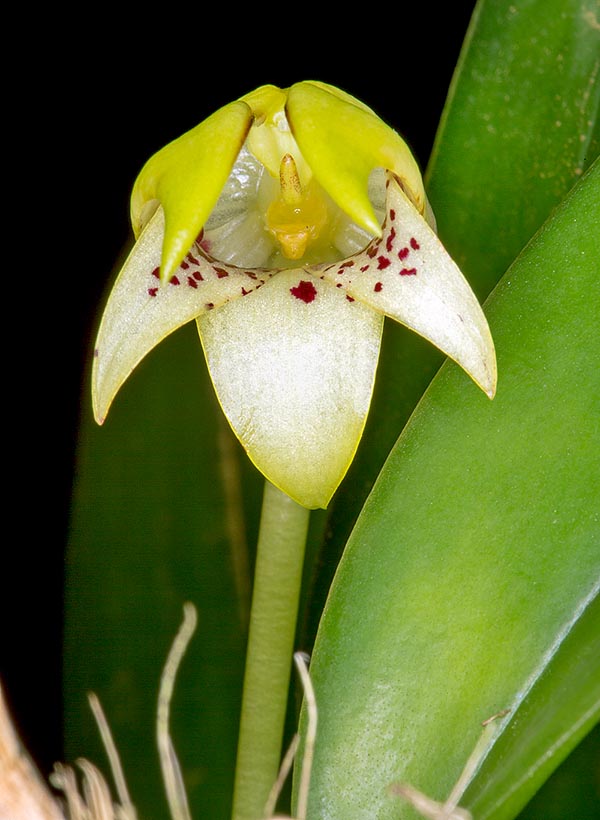Family : Orchidaceae

Text © Pietro Puccio

English translation by Mario Beltramini
The species is native to New Guinea and to Philipines (Luzon, Mindanao and Samar) where it grows on the trees of the humid forests between the 100 and the 1100 m of altitude.
The name of the genus is the combination of the Greek substantives “βολβός” (bolbos) = bulb and “φύλλον” (phyllon) = leaf, with reference to the leaves growing at the apex of the pseudobulbs; the species is honoured to the German anthropologist and ethnologist Georg Karl Cornelius Gerland (1833-1919).
Common names: Gerland’s bulbophyllum (English).

The Bulbophyllum gerlandianum Kraenzl. (1886) is an epiphytic species with creeping rhizome rooting at the nodes, of 0,5-0,7 cm of diameter, numerous filiform roots and ovoidal pseudobulbs, 1-2,5 cm tall and of 0,8-1 cm of diameter, spaced of 2-10 cm.
Oblong leaves with emarginate apex, 10-26 cm long and 3-6 cm broad, coriaceous, of dark green colour and glossy.
Basal inflorescences bearing only one flower, on a 2-2,5 cm long peduncle, not completely open, of pale yellow colour more or less densely red dotted and intensely perfumed; about 5 cm long pedicel and ovary.

The flowers, not opening comletely, are pollinated by the fruit flies © Giuseppe Mazza
Ovate-elliptical lateral petals with acuminate apex, slightly curved, 1,4-2,6 cm long and 0,5-1 cm broad, fleshy labellum curved in the central part, triangular in the terminal one, obtuse, 0,6-0,8 cm long and 0,3-0,6 cm broad, and 0,3-0,4 cm long column.
The flowers are pollinated by the males of various species of fruit fly, in particular of the genus Bactrocera Macquart, 1835, like for the Bulbophyllum patens King ex Hook.f. (1890).
It reproduces by seed, in vitro, and by division, with each section provided of at least 3-4 pseudobulbs.
Floriferous species practically unknown in cultivation, present almost exclusively in specialized collections, requires a slightly shaded exposition, intermediate temperatures, 20-30 °C, high humidity, 70-80%, and constant ventilation.
Frequent waterings and nebulizations during the period of growth of the pseudobulbs, more reduced during the vegetative rest, but without ever allowing the substratum to dry up completely, utilizing rain water, demineralized or by reverse osmosis.
It may be mounted on trunks, bark or rafts of cork or of roots of arborescent ferns, with sphagnum at the base to keep the humidity, or cultivated in pots or baskets, ample enough to allow the rhizome to freely elongate, with substratum formed by fragments of medium sliced bark, sphagnum and inerts to improve the drainage and the ventilation of the roots.
The species is reported in the appendix II of the CITES (species whose trade is ruled internationally).
Synonyms: Bulbophyllum macranthum var. albescens J.J.Sm. (1905); Bulbophyllum truncicola Schltr. (1913); Bulbophyllum emiliorum Ames & Quisumb. (1931).
→ For general notions about ORCHIDACEAE please click here.
